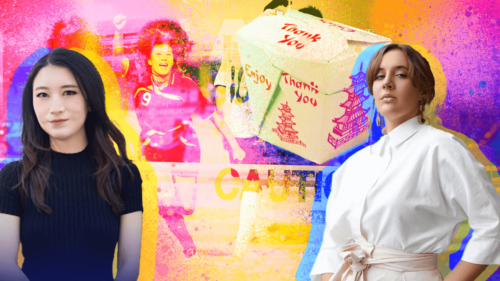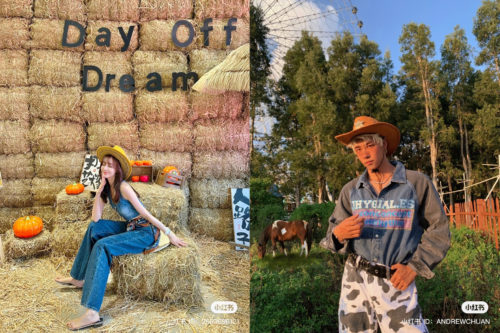Shanghai Fashion Week 2017: Minimalism, food, ancient China, and other themes and trends
The recently concluded Shanghai Fashion Week saw emerging Chinese designers going all out to create curious, inventive new looks.

The 15th edition of Shanghai Fashion Week (SFW), which ran from October 11 to 18, was about more than just catwalks in Shanghai’s fashion central of Xintiandi. Complementing runway shows were immersive showrooms and events scattered across the city (such as Labelhood, a base camp for emerging talent, and XCOMMONS, an exhibition for established designers), designed for engagement and influence. It was clear that Shanghai Fashion Week aims to be the “most influential fashion trade platform in Asia,” as SFW vice secretary-general Lu Xiaolei 吕晓磊 told Business of Fashion.
Here at The China Project, we want to present three trends we saw in this season’s SFW — themed “Boundless” — and highlight the designers and brands that best exemplified them.

1. Back to the roots — ancient China-inspired modernwear
We’ve previously written about the growing number of international Chinese students returning home. In a similar vein, this year’s SFW has seen an unprecedented takeover by Chinese designers who studied overseas in prestigious fashion institutes such as Central Saint Martins in London and Istituto Marangoni in Milan.
But it’s not just about returning home in a physical sense; it’s drawing inspiration from one’s home’s culture and history. The designers we picked in this section share aspirations of returning to their Chinese roots and encouraging younger generations to do the same.
As Mukzin’s chief designer, Kate Han, told us, “If you want to set up some kind of order in chaos, you have to remember where you come from.” Duly noted.
Mukzin

Mukzin 密扇 (mìshàn) was founded by Kate Han and her husband, George Feng, in 2014, aiming to give traditional Chinese costumes a modern twist.
In this collection, Mukzin imagines a world called “Chaos of Mountains and Seas,” where the Chinese classic story Shan Hai Jing (山海经, shānhǎijīng, Classic of Mountains and Seas, about mythical gods and creatures) meets Jurassic World, told in extravagant patterns, a mix of textures, and 3D-printed bone-like accessories.
Heaven Gaia

Looking too heavenly for an everyday occasion? You aren’t wrong — Xiong Ying (Xiur), the chief designer behind Heaven Gaia, is known for making couture dresses for China’s Spring Festival Gala (春晚 chūnwǎn), arguably the biggest TV show in the world. As a young brand founded in 2013, it made an impressive appearance at Paris Fashion Week earlier this year.
In this collection, Heaven Gaia aimed to revive the Four Great Beauties (四大美人 sìdà měirén), who gained their reputation not just for their looks, but also for their influence over emperors. Working with exquisite materials and details, Xiur also hopes to go beyond style by demonstrating her handcraft skills.
2. Fashion meets food
This isn’t the first time we’ve seen the fusion of food and fashion; Moschino produced a McDonald’s line in 2014, and more recently, Taco Bell partnered with American clothing company Forever 21.
But food brands are having a hard time everywhere, including China, where people are embracing a healthier lifestyle by turning to avocado munchies, etc. As Pizza Hut China’s sales continue to flatten out and Häagen-Dazs embarks on a global rebrand, you have to give them some credit for trying to win China’s fashion-minded millennials. Nice? Or nice try?
Pizza Hut x Georgette Q

Qiao Qi left China for the U.K. at age 14. Eleven years later, with a degree from the London College of Fashion and a stint at Alexander McQueen, she returned to Beijing and launched her own label, Georgette Q. With a fabric design background, she pays particular attention to clothing materials, aiming to make what modern Chinese women really want.
Inspired by Pizza Hut’s fall menu designed for the China market, this “Food is Fashion” collection includes elements of durian pizza, roasted vegetables, and tea drinks. Qiao thinks food can reflect the aesthetics of a designer or a brand.
Häagen-Dazs x Vmajor

Hailing from Shenzhen, China’s manufactory capital, Vmajor the moniker combines the first letter of its co-founder’s name and a musical term. It was founded by Victor Zhu and Nicole Lin in 2012, and just after two years, it won the esteemed Woolmark Prize for Asia.
Having just come back from Australia’s Fashion Week in May, Zhu stunned Shanghai with his collaboration with renowned French chef Jean-Francois Arnaud, themed “Global Citizen on Tour.” While you might be able to catch some west coast vibes and a sense of hedonism from the collection, can you also tell that those accessories are made with fondant?
3. Upgraded simplicity (minimalism with texture)
Ever since Tencent founder Ma Huateng 马化腾 coined the term consumption upgrade (消费升级 xiāofèi shēngjí) in 2016, indicating that Chinese people’s level and quality of consumption are ticking up, pan-lifestyle-focused business leaders have been actively engaged in the conversation to hold onto their upwardly mobile customers.
On the one hand, consumers have more money; on the other, they are getting pickier about their quality of life, which of course includes fashion. This season, we have seen minimalism making a return, but with an upgrade on the attention given to texture and fabric. Ma Huateng would be proud.
Wanbing Huang

As a London-based womenswear fashion designer, Wanbing Huang launched her eponymous label in October 2016 on the Labelhood stage of Shanghai Fashion Week, and soon grabbed the attention of both the Chinese and international fashion audience.
In her latest collection, “Memory Shards,” Huang explores light and the ocean. “I took inspiration from my very first memory of the world, the light,” the designer writes on her website. “In particular, I focused on the reflection of the light on the surface of the water and rays of light penetrating the sea.”
mu

Ten-year-old mu’s name stands for Moda Union, and is one of the more senior brands on our list. As an independent brand that encourages “everything about a better life,” mu hopes to help people find their inner peace and an ideal way of living. Just exactly what everyone needs.
This collection was inspired by works from the American painter Cy Twombly, who is famous for his abstract expressionism. See the resemblance?






